Wesley Mackenzie is failing senior year — thanks to his unchecked anger, rowdy friends and a tendency to ditch his homework for skateboarding and a secret photography obsession. Then he meets and gets an instant crush on ballet dancer Tristian Monroe.
Wes is as closeted as they come, but slowly he feels driven by a new sense of purpose and begins to think that maybe he can change for the better and graduate on time. As a falling out with his friends becomes inevitable, Wes realizes that being himself means taking a stand — and blowing up the bad-boy reputation he never wanted in the first place.
Skater Boy drew me in with a familiar resonance reminiscent of Avril Lavigne’s song. The opening chords of the narrative seemed to echo the lyrics,
He was a boy
She was a girl
Can I make it any more obvious?
He was a punk
She did ballet
What more can I say?
He wanted her
She’d never tell
Secretly she wanted him as well
But all of her friends
Stuck up their nose
They had a problem with his baggy clothes.
Much like the song above, the book delves into the complexities of teenage life, relationships and the struggle to break free from societal expectations.
Given that I work as a tutor and counselor, I find the teacher in main character Wesley Mackenzie’s school a character who struck a chord. The portrayal of teens resistant to guidance mirrors the reality I’ve encountered at school—youth grappling with identity and personal struggles, often hesitant to open up to teachers or parents. This book authentically captures the challenges and resistance faced by counselors in reaching out to these teens.
What stood out for me was the commendable characterization, especially the inclusion of LGBTQIA characters like Wes, Tristan, Emily, Brad and Stye. The diversity represented, with Wes being gay, Tristan being gay, and Stye identifying as bisexual, adds depth to the narrative. The novel also addresses important issues such as bullying, homophobia, mental health and substance abuse, providing a well-rounded exploration of the challenges faced by today’s youth.
The chapter titles were a delight, aptly capturing the essence of each section. However, not all characters received equal development, with Emily, for instance, feeling somewhat lost in the storyline. (I did not see her from Chapter 20 up to the last chapter, Chapter 27; only saw her waving in the epilogue).
What truly shines in this narrative is Wes’ journey toward self-acceptance and breaking away from societal expectations. His struggle to reconcile his tough facade with his true self, especially when encountering Tristan, who challenges his perceptions, is both heartfelt and relatable.
I would recommend Skater Boy to high school teens navigating their identities and battling with self-discovery.
-Weldon Ngetich


